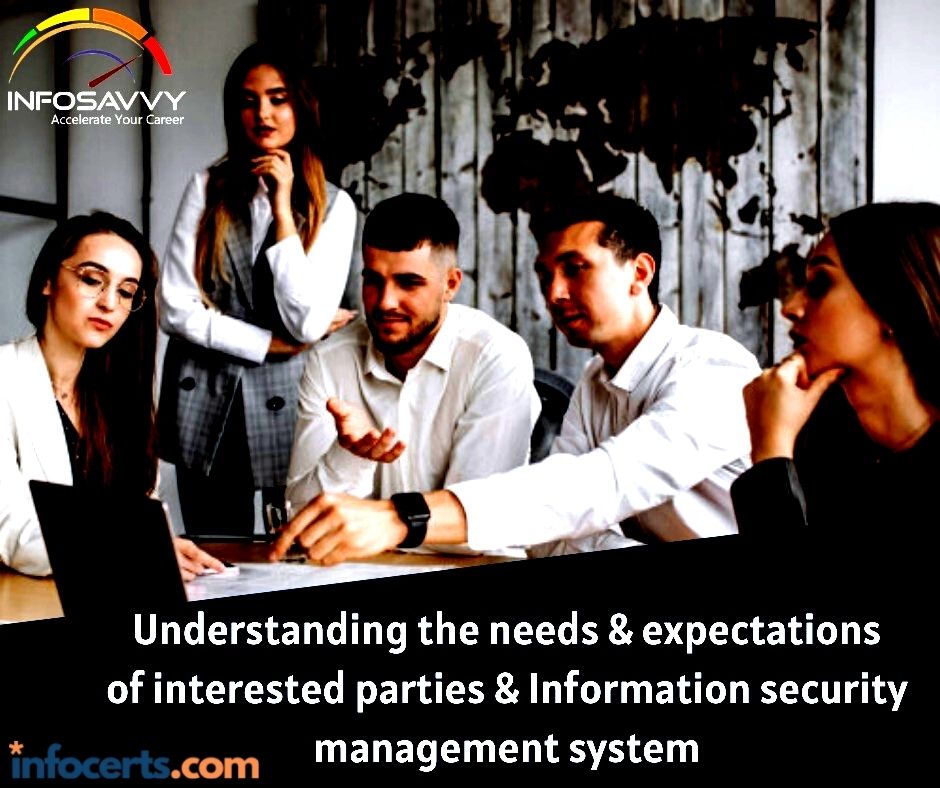ISO 27001 Clause 4.2 & 4.4 Implementation Guideline this concept would be clear over here through this article etc.
Clause 4.2 Understanding the needs and expectations of interested parties
Required activity
The organization determines interested parties relevant to the ISMS and their requirements relevant to information security.
Explanation
Interested party may be a defined term that refers to persons or organizations which will affect, be suffering from , or perceive themselves to be suffering from a choice or activity of the organization. Interested parties are often found both outside and inside the organization and may have specific needs, expectations and requirements for the organization’s information security.
External interested parties can include:
a) Regulators and legislators;
b) Shareholders including owners and investors;
c) Suppliers including subcontractors, consultants, and outsourcing partners;
d) Industry associations;
e) Competitors;
f) Customers and consumers;
g) Activist groups.
Internal interested parties can include:
a) Decision makers including top management;
b) Process owners, system owners, and knowledge owners;
c) Support functions like IT or Human Resources;
d) Employees and users;
e) Information security professionals.
Implementation Guidance
The following steps should be taken:
— identify external interested parties;
— identify internal interested parties;
— identify requirements of interested parties.
As the needs, expectations and requirement of interested parties change over time, these changes and their influence on the scope, constraints and requirements of the ISMS should be reviewed regularly.
Documented information on this activity and its outcome is mandatory only within the form and to the extent the organization determines as necessary for the effectiveness of its management system .
Clause 4.4 Information security management system
Required activity
The organization establishes implements, maintains and continually improves the ISMS.
Explanation
ISO/IEC 27001:2013, 4.4 states the central requirement for establishing, implementing, maintaining and continually improving an ISMS. While the opposite parts of ISO/IEC 27001 describe the specified elements of an ISMS, 4.4 mandates the organization to make sure that each one required elements are met so as to determine , implement, maintain and continually improve the ISMS.
Questions related to this topic
- Explain ISO 27001 Clause 4.2 & 4.4 Implementation Guideline?
ISO 27001 Requirements
Clause 4.3 Determining the scope of the information security management system
Clause 5.1 Leadership and commitment
Clause 5.2 Policy
Clause 5.3 Organizational roles, responsibilities and authorities
Clause 6.1 Actions to address risks and opportunities
Clause 6.1.2 Information security risk assessment process
Clause 6.1.3 Information security risk treatment
Clause 6.2 Information security objectives & planning
Clause 7.1 Resources
Clause 7.2 Competence
Clause 7.3 Awareness
Clause 7.4 Communication
Clause 7.5 Documented information Implementation Guideline
Clause 8.1 Operational planning & control
Clause 8.2 Information security risk assessment
Clause 8.3 Information security risk treatment
Clause 9.1 Performance evaluation Monitoring, measurement, analysis & evaluation
Clause 9.2 Internal audit
Clause 9.3 Management review
Clause 10.1 Non conformity and corrective action
Clause 10.2 Continual Improvement
ISO 27001 Annex A Controls
Annex A.5 Information Security Policies
Annex A.6 Organization of Information Security
Annex A.6.2 Mobile Devices and Teleworking
Annex A.7 Human Resource Security
Annex A.7.2 During Employment
Annex A.7.3 Termination and Change of Employment
Annex A.8 Asset Management
Annex A.8.1.3 Acceptable Use of Assets & A.8.1.4 Return of Assets
Annex A.8.2 Information Classification
Annex A.8.2.2 Labeling of Information & A.8.2.3 Handling of Assets
Annex A.8.3 Media Handling
Annex A.9 Access Control
Annex A.9.1.2 Access to Networks and Network Services
Annex A.9.2 User Access Management
Annex A.9.2.3 Management of Privileged Access Rights
Annex A.9.2.4 Management of Secret Authentication Information of Users
Annex A.9.2.5 Review of User Access Rights
Annex A.9.2.6 Removal or Adjustment of Access Rights
Annex A.9.3 User Responsibilities
Annex A.9.4 System and Application Access Control
Annex A.9.4.4 Use of Privileged Utility Programs
Annex A.9.4.5 Access Control to Program Source Code
Annex A.10 Cryptography
Annex A.11 Physical and Environmental Security
Annex A.11.2 Equipment
Annex A.11.1.3 Securing Offices, Rooms and Facilities
Annex A.11.1.4 Protecting Against External and Environmental Threats
Annex A.11.1.5 Working in Secure Areas
Annex A.11.1.6 Delivery and Loading Areas
Annex A.11.2.4 Equipment Maintenance
Annex A.11.2.5 Removal of Assets
Annex A.11.2.6 Security of Kit and Assets Off-Premises
Annex A.11.2.7 Secure Disposal or Re-use of Equipment
Annex A.11.2.8 Unattended User Equipment
Annex A.11.2.9 Clear Desk and Clear Screen Policy
Annex A.12 Operations Security
Annex A.12.2 Protection from Malware
Annex A.12.3 Backup
Annex A.12.4 Logging and Monitoring
Annex A.12.5 Control of Operational Software
Annex A.12.6 Technical Vulnerability Management
Annex A.12.7 Information Systems Audit Considerations
Annex A.13 Communications Security
Annex A.13.2 Information Transfer
Annex A.13.2.3 Electronic Messaging
Annex A.13.2.4 Confidentiality or Non-Disclosure Agreements
Annex 14 System Acquisition, Development and Maintenance
Annex A.14.1.2 Securing Application Services on Public Networks
Annex A.14.1.3 Protecting Application Services Transactions
Annex A.14.2 Security in Development and Support Processes
Annex A.14.2.3 Technical Review of Applications after Operating Platform Changes
Annex A.14.2.4 Restrictions on Changes to Software Packages
Annex A.14.2.5 Secure System Engineering Principles
Annex A.14.2.6 Secure Development Environment
Annex A.14.2.7 Outsourced Development
Annex A.14.2.8 System Security Testing
Annex A.14.2.9 System Acceptance Testing
Annex A.14.3 Test data
Annex A.15 Supplier Relationships
Annex A.15.1.2 Addressing Security Within Supplier Agreements
Annex A.15.1.3 Information and Communication Technology Supply Chain
Annex A.15.2 Supplier Service Delivery Management
Annex A.16 Information Security Incident Management
Annex A.16.1.2 Reporting Information Security Events
Annex A.16.1.3 Reporting Information Security Weaknesses
Annex A.16.1.4 Assessment of and Decision on Information Security Events
Annex A.16.1.5 Response to Information Security Incidents
Annex A.16.1.6 Learning from Information Security Incidents
Annex A.16.1.7 Collection of Evidence
Annex A.17 Information Security Aspects of Business Continuity Management
Annex A.17.1.3 Verify, Review and Evaluate Information Security Continuity
Annex A.18 Compliance
Annex A.18.1.3 Protection of Records
Annex A.18.1.4 Privacy and Protection of Personally Identifiable Information
Annex A.18.1.5 Regulation of Cryptographic Controls
Annex 18.2 Information Security Reviews
About ISO 27002
- ISO 27002 – INTRODUCTION
- ISO 27002 Information technology Security techniques Code of practice for information security controls
This Blog Article is posted by
Infosavvy, 5B 306 Riverside Greens, Panvel, Raigad 410206 Maharashtra, India
Contact us – www.infocerts.com

